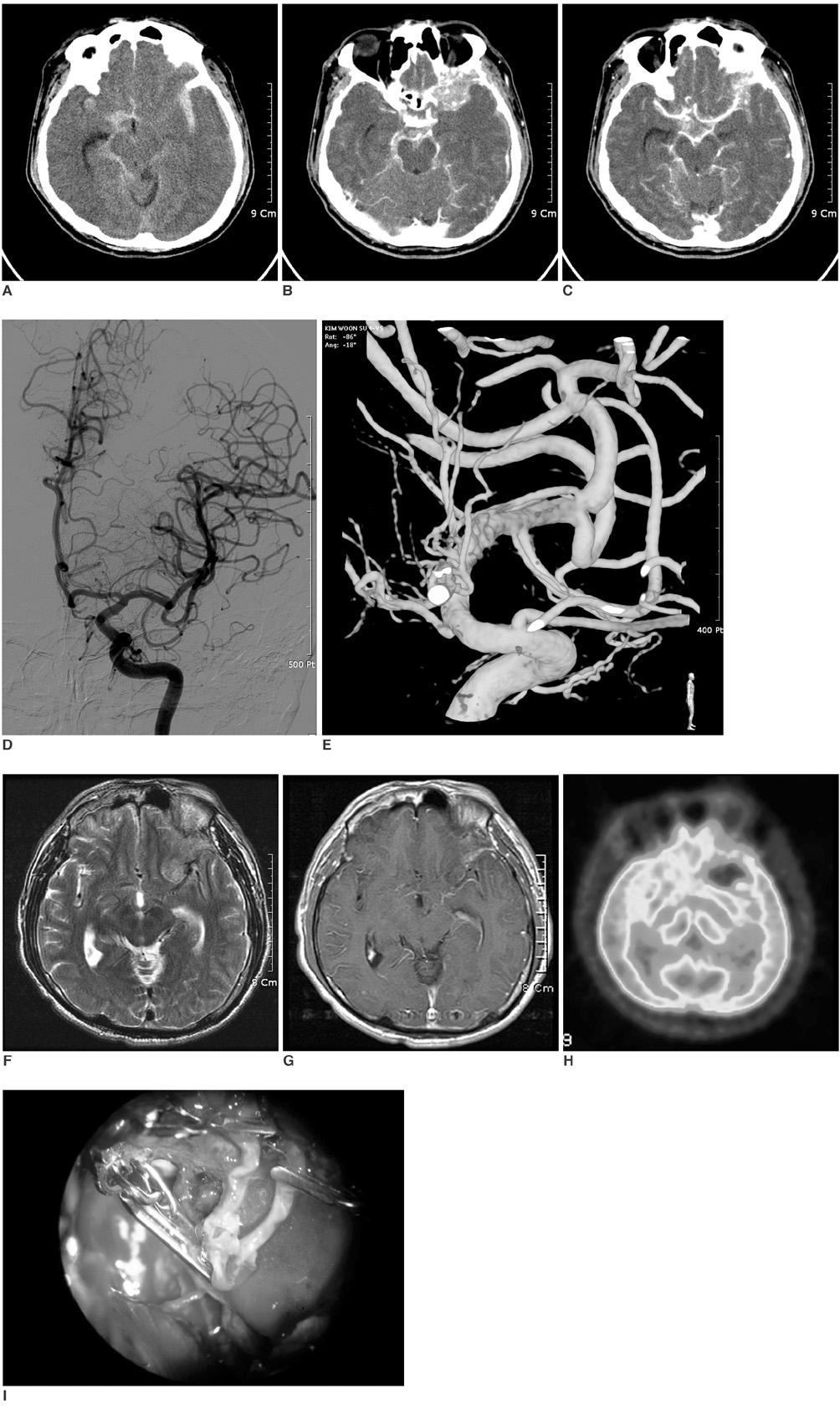Korean J Radiol.
2008 Jul;9(Suppl):S10-S13. 10.3348/kjr.2008.9.s.s10.
A "Benign" Sphenoid Ridge Meningioma Manifesting as a Subarachnoid Hemorrhage Associated with Tumor Invasion into the Middle Cerebral Artery
- Affiliations
-
- 1Department of Diagnostic Radiology, Ajou University School of Medicine, Gyeonggi-do, Korea. J978005@lycos.co.kr
- KMID: 1100095
- DOI: http://doi.org/10.3348/kjr.2008.9.s.s10
Abstract
- Meningioma rarely manifests as a subarachnoid hemorrhage (SAH), and invasion directly into a major intracranial artery is extremely rare. To the best of our knowledge, meningioma presenting with an SAH associated with major intracranial arterial invasion has never been reported. We present a case of sphenoid ridge meningotheliomatous meningioma manifesting as an SAH without pathologically atypical or malignant features, due to direct tumor invasion into the middle cerebral artery.
MeSH Terms
Figure
Reference
-
1. Roser F, Nakamura M, Jacobs C, Vorkapic P, Samii M. Sphenoid wing meningiomas with osseous involvement. Surg Neurol. 2005. 64:37–43.2. Shaffrey ME, Dolenc VV, Lanzino G, Wolcott WP, Shaffrey CI. Invasion of the internal carotid artery by cavernous sinus meningiomas. Surg Neurol. 1999. 52:167–171.3. Kim DG, Park CK, Paek SH, Choe GY, Gwak HS, Yoo H, et al. Meningioma manifesting intracerebral hemorrhage: a possible mechanism of haemorrhage. Acta Neurochir (Wien). 2000. 142:165–168.4. Niiro M, Ishimaru K, Hirano H, Yunoue S, Kuratsu J. Clinico-pathological study of meningiomas with haemorrhagic onset. Acta Neurochir (Wien). 2003. 145:767–772.5. Bosnjak R, Derham C, Popovic M, Ravnik J. Spontaneous intracranial meningioma bleeding: clinicopathological features and outcome. J Neurosurg. 2005. 103:473–484.6. Locksley HB, Sahs AL, Sandler R. Report on the cooperative study of intracranial aneurysms and subarachnoid hemorrhage. 3. Subarachnoid hemorrhage unrelated to intracranial aneurysm and A-V malformation A study of associated diseases and prognosis. J Neurosurg. 1966. 24:1034–1056.7. Pluchino F, Lodrini S, Savoiardo M. Subarachnoid hemorrhage and meningioma. Report of two cases. Acta Neurochir (Wien). 1983. 68:45–53.8. Yucesoy K, Ozer H, Erdag N, Mertol T. Meningioma presented as subarachnoid haemorrhage: case report. Kobe J Med Sci. 1999. 45:213–219.9. Kotapka MJ, Kalia KK, Martinez AJ, Sekhar LN. Infiltration of the carotid artery by cavernous sinus meningioma. J Neurosurg. 1994. 81:252–255.
- Full Text Links
- Actions
-
Cited
- CITED
-
- Close
- Share
- Similar articles
-
- Sphenoid Ridge Meningioma Presenting as Acute Cerebral Infarction
- Subarachnoid Hemorrhage Due to a Ruptured Middle Cerebral Artery Bifurcation Aneurysm Superimposed by an Idiopathic Intracerebral Hematoma
- Traumatic Intracerebral and Subarachnoid Hemorrhage Due to a Ruptured Pseudoaneurysm of Middle Meningeal Artery Accompanied by a Medial Sphenoid Wing Dural Arteriovenous Fistula
- Roentgenologic analysis of meningioma
- The statistical observation for frequancy of occurence of the anencephalus


